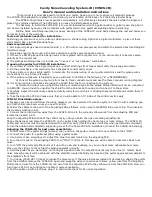
c) When the receiver passes over a mass, the frequency will
increase. The rise in frequency depends on the proximity
of the buried mass. A sharp increase indicates a shallow
mass, probably no more than 6 inches deep. A slight
increase indicates a depth probably greater than a foot.
In either case, the center of the mass will be found below
the point of highest frequency.
d) When locating a large mass, such as a manhole, it may be
helpful to find the edges of the mass rather than the cen-
ter. To locate the edges, scan the area around the mass,
marking locations where a sharp frequency rise occurs. If
you mark 3 or 4 evenly spaced locations around the
perimeter you may use these to trace the outline of the
manhole. Also, these markings will help you more accu-
rately visualize the center of the manhole.
e) The SIGNAL LEVEL control may be adjusted in this mode
to provide a visual response on the light bar meter.
Generally, an increase in the light bar meter reading will
correspond to a frequency rise due to the presence of a
mass.
f) NOTE: The SENSITIVITY button has no function in mass-
locating mode, and may be left on either setting.
26







































